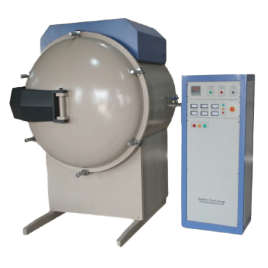
The Role of Vacuum Furnaces
Picture this: a state-of-the-art furnace operating in a vacuum, an environment where the usual rules of heat treatment don't quite apply. Intriguing, isn't it? Vacuum furnaces silently revolutionize how we approach material processing. By creating a vacuum – essentially an airless space – these furnaces allow us to heat materials in a way that's incredibly precise and free from the typical environmental contaminants that can affect quality. This means fewer imperfections and a better end product for you.
Whether it's hardening a piece of aerospace metal to withstand extreme conditions or crafting dental equipment that meets stringent hygiene standards, vacuum heat treatment is at the heart of it all. The benefits of vacuum furnace systems extend beyond heating; they're pivotal in ensuring that the materials you rely on are strong, uniformly treated and of the highest quality.
8 Vacuum Heat Treatment Advantages
Vacuum heat treatment technology, a marvel in the field of material processing, offers several advantages that make it a preferred choice for a wide range of industrial applications. Let's explore these benefits that are driving more and more businesses toward this innovative solution:
1. Enhanced Product Quality
- Minimized Oxidation and Decarburization: In the absence of air, materials processed in vacuum furnaces are less prone to oxidation and decarburization. This results in a cleaner, smoother surface finish, preserving the integrity and appearance of the product.
- Consistency in Results: Vacuum furnace systems deliver uniform heating, which ensures consistent quality across batches. This is vital for industries where precision is non-negotiable.
2. Precise Temperature Control
- Accurate Heat Application: The ability to precisely control temperature in vacuum furnaces means that heat is applied exactly where and how it's needed, ensuring optimal treatment of materials.
- Customized Heat Profiles: Different materials require different heat treatment profiles. Vacuum furnaces allow for such customization, catering to the unique properties of each material.
3. Uniform Heating and Cooling
- Even Material Properties: Uniform heating and cooling prevent the development of stress and distortion in materials, ensuring their strength and durability.
- Improved Material Performance: This uniformity translates to improved performance characteristics of the materials, which is essential in high-stress applications like aerospace or automotive parts.
4. Increased Process Efficiency
- Faster Cycle Times: Vacuum furnaces can reach the desired temperatures more rapidly than conventional furnaces, leading to shorter overall processing times.
- Energy Efficiency: These furnaces are generally more energy-efficient, reducing operational costs and benefiting the environment.
5. Environmentally Friendly Process
- Reduced Emissions: With no need for combustion in a vacuum, these furnaces emit fewer pollutants, making them a greener option.
- Lower Carbon Footprint: The overall process efficiency and reduced energy consumption contribute to a lower carbon footprint.
6. Versatility in Applications
- Broad Material Compatibility: From metals to ceramics, vacuum furnace heat treatment is used to process a wide variety of materials, making these furnaces versatile tools in many industries.
- Adaptable for Different Processes: Be it annealing, brazing, sintering or hardening, vacuum furnaces are adaptable to various heat treatment processes.
7. Enhanced Safety Features
- Reduced Fire Risk: Operating in a vacuum means there's no oxygen to fuel fires, significantly reducing the risk of accidents.
- Controlled Atmosphere: The controlled environment inside a vacuum furnace improves quality and enhances operator safety.
8. Long-Term Cost Savings
- Lower Maintenance Costs: Vacuum furnaces typically require less maintenance than traditional furnaces.
- Extended Lifespan of Products: The high-quality treatment extends the lifespan of treated materials, offering long-term cost benefits to users.
Choosing the Right Vacuum Furnace
When selecting the ideal vacuum furnace for your business, you're investing in a solution that will enhance your operational efficiency, product quality and overall competitiveness. Here's a guide to help you make the right choice:

Assess Your Specific Vacuum Heat Treating Needs
Understand the types of materials you'll be processing and their specific vacuum heat treating needs. Different materials may require different temperature ranges and atmospheres. Also, consider the desired properties of your finished product, such as hardness, durability or corrosion resistance, to determine the furnace specifications.
Understand the Different Types of Vacuum Furnace Systems
Vacuum furnace systems come in various types, each serving a different purpose and with its own set of advantages. Match the type of furnace to your specific applications, whether it's for annealing, brazing, sintering or another process.
Consider Size and Capacity
Evaluate the available space in your facility to ensure the furnace fits comfortably with adequate room for operation and maintenance. Estimate your processing volume to choose a furnace size that can handle your workload efficiently without underutilization or overloading.
Evaluate Temperature and Vacuum Levels
Ensure the furnace can reach and accurately maintain the required temperature ranges. The level of vacuum (measured in torr) is crucial, especially for processes requiring ultra-high vacuums. Ensure the furnace meets your specific vacuum requirements.
Check for Customization and Flexibility
Some processes require customized features. SentroTech will work with you to tailor the furnace to your specific needs. We can also discuss how the furnace can be adapted or upgraded in the future as your business grows or as technology advances.
Assess Energy Efficiency and Operating Costs
Look for energy-efficient models to reduce operational costs and environmental impact. Consider the long-term costs of operating and maintaining the furnace, including spare parts and service availability.
Frequently Asked Questions: Vacuum Furnaces
Below are answers to common questions about vacuum furnaces. Please contact us if you'd like more information on this topic.
How Does a Vacuum Furnace Work?
A vacuum furnace is a type of furnace that heats materials – typically metals or ceramics – in a vacuum environment. This absence of air or other gasses prevents unwanted chemical reactions during vacuum furnace heat treatment, leading to higher-quality outcomes. Vacuum furnaces remove the air inside the chamber and heat the material to a specific temperature, allowing for precise control and uniform heating.
What Is the Process of Vacuum Heat Treatment?
Vacuum heat treatment is a method where materials – typically metals or ceramics – undergo heating in a vacuum-sealed furnace to modify their physical and chemical properties. The process starts with preparing and placing the material in the furnace, followed by evacuating air to create a vacuum, thus preventing oxidation and contamination. The material is then heated to a specific temperature, precisely controlled for uniform treatment. Optional cooling may follow, either in the vacuum or a controlled atmosphere, depending on the desired material characteristics. After the treatment, quality control tests ensure the material meets the necessary specifications, completing a process known for its high-quality, consistent results.
What Is the Temperature of a Vacuum Furnace?
The temperature range of a vacuum furnace varies depending on its design and purpose. SentroTech vacuum furnace systems, for example, operate at temperatures up to 1,600°C (2,912°F). This allows for the treatment of a variety of materials, from metals to ceramics, with the exact temperature being precisely controlled to suit the specific requirements of each heat treatment process, such as hardening, sintering or annealing. The ability to reach and maintain such high temperatures in a controlled environment is a key feature that makes vacuum furnace heat treatment ideal for advanced material processing applications.
Rely on SentroTech for Vacuum Furnaces That Perform Time After Time
Discover the benefits of vacuum furnaces from SentroTech, designed to deliver consistent, top-quality results. Our state-of-the-art furnaces offer precise temperature control, uniform heating and adaptability for various materials and processes. SentroTech vacuum furnaces meet your immediate needs and also support your future growth.
Request a quote today and let's discuss how we can provide you with the vacuum heating treatment that best suits your manufacturing process.
Request a QuoteHigh-Temperature Vacuum Furnaces | Sentro Tech
With a versatility that matches a range of heat treatment processes, SentroTech vacuum furnaces are available in sizes to fit your needs and budget.



